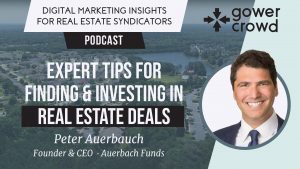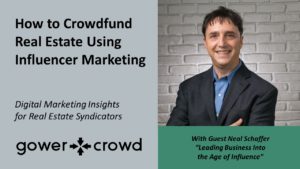Max Sharkansky - Managing Partner, Trion Properties
How to Grow an Apartment Portfolio From $13 million to $1 billion in 10 Years
 Max Sharkansky - Managing Partner at Trion Properties
Max Sharkansky - Managing Partner at Trion Properties
Max is one of the foremost multifamily sponsors in the nation and the story of how he built Trion Properties’ portfolio with his partner Mitch Paskover from $13 million to over $1 billion is what you are going to hear about in today’s episode.
You will also learn why Max decided to expand Trion’s reach to the southeast, the opportunities he sees there, and how it compares with transacting on the West, especially in California.
Trion was one of GowerCrowd’s earliest clients when they had a mere $300 million portfolio and in today’s episode you will also discover why the company chose to embrace crowdfunding to capitalize their deals and how they plan to finance their next billion dollars of acquisitions.
What You're Going to Learn
- Why $13 Million to $1 Billion in Assets Takes Time, Money and Effort to Build
- How They Got Half a Billion Plus Annually in Real Estate Deals as Both Syndications and Joint Ventures
- How More People, More Software and More Technology Resulted in Business Growth
- Why Migration is Leading to Real Estate Opportunities in Florida, Georgia and the Carolinas
- What are the Best Rent Growth Environments in American History
- Why Investors Are Concerned About Inflation
- Why Interest Rate Increases are a Major Component of Real Estate Investing
- How Interest Rate Increases Will Impact Investors With Floating Rate Debt
- Why Ground-Up Real Estate Development Can is a Challenge
- What to Look For When Investing in a Crowdfunded Syndication For the First Time
Related article: The Ultimate Guide to Crowdfunding Real Estate Development
Listen To or Watch the Full Podcast Here
Show Highlights
FOR REAL ESTATE DEVELOPERS
THE WHITE BOARD WORKSHOP
Learn the exact system best of class sponsors use to raise money online.
$13 Million to $1 Billion in Assets Takes Time, Money and Effort to Build
Adam Gower: Max, it's just such a huge pleasure to see you again now that you have fled the state. I have only one question for you to start with, of course, one question to start with. Apart, of course, from the crowdfunding platform we built for you. What was the secret to your getting from $13 million to a billion dollars in assets in just 10 years? Amazing story. I want to know the secret.
Max Sharkansky: Um, brick by brick, you know. I wish I could tell you a secret. I wish there was one magic bullet. There really isn't. You know, it's just constant hard work. Thinking outside the box. We did a lot of - we spent a lot of time and money raising capital. Just like we spent a lot of time and money meeting with brokers and finding deals and operations. And we, you know, just like building any business, you kind of got to build every department one piece at a time. So, we had the acquisitions. The acquisitions piece, I guess that always comes first, because that was my background, right? So, we had acquisitions, naturally, but then you've got to figure out raising capital and that's breakfast, lunch and dinner, for sure, with investors. In 2011, I believe it was, the JOBS Act came along, which was huge for our business. And, we got in very, very early and we started to raise capital online and we got a lot of investors online. And we have gone to a lot of conferences. We've done everything possible to get our name out and to raise as much capital as possible, and we could never have grown the portfolio to the size that we did today without spending that much time and money and effort raising capital.
Half a Billion Plus Annually in Real Estate Deals as Both Syndications and Joint Ventures
Adam Gower: You and I have known each other for actually a very long time now. The years just keep piling on. But when we were talking about crowd funding very, very first time, I don't know, five years ago or so, the conversation was that you were thinking of looking at institutional capital. And I asked why -why not consider like doing your own crowdfunding? Tell me about that experience and what that's looked like for you as a private equity shop in terms of the capital formation you have, instead of having big single checks, now you've got hundreds and hundreds of individual investors.
Max Sharkansky: We bought a deal for $108 million with $118 million capitalization and a $32 million equity check. So that equity, we syndicated it as opposed to doing institutional and doing it in a JV format. We did it with 300 plus investors. It was actually closer to 400 investors. And I was joking with my partner. That's less of a syndication. It's more of an IPO at that point because it's so many investors. But we got it done. So that said, we can't do that sequentially because we're doing a lot of deals. We're doing 10 plus deals a year. Last year, we did about half a billion and we can't - even though we have a thousand active investors right now, we can't go back to them once every 2-3 weeks for a new syndication. So we still do a lot of JVs. We have great relationships with some phenomenal partners and we'll continue that for the next few years. At some point, will we have 3,000, 4,000, 5,000 investors? Yes, that's possible. And at that point, will we do less institutional joint ventures? Probably. But for now, we've got our 1,000 investors and continuing to do half a billion plus annually and we'll do them in both formats of a syndication and a joint venture.
More People, More Software and More Technology Resulted in Business Growth
Adam Gower: It's interesting that you say that. With a thousand investors, one of the biggest concerns that sponsors have, when they first get into crowdfunding is, how to handle so many investors. Instead of having to just talk to one or two institutional investors, you've got hundreds of. What's been your experience of that?
Max Sharkansky: I mean, it's very simple. You just have to hire people. A sponsor is not a person. A sponsor is an organization. Right? So you have to grow the organization. If you've read any books by Jim Collins, you know, he talks about: your growth ends when you stop your hiring. So, you have to just continue to hire and continue to grow the business. You know Andrew Lucas very well. Andrew has been with us for many, many years now, and he's our Director of Capital Markets and he oversees all of our IRR. He now has an associate because we've grown the business to a scale where he needs some help so he can continue to do what he does best and bring in more investors into the business. And, we have the software set up. We use Juniper Square, and they're phenomenal. And you know, you just - you keep playing that game. You just keep snowballing with more people, more software and more technology, and that's how you grow any business.
Migration Leading to Real Estate Opportunities in Florida, Georgia and the Carolinas
Adam Gower: Just recently, you fled the Golden State for the Sunshine State. Why? Was there not enough gold in California? Tell me, what's the story behind that?
Max Sharkansky: The gold was being taxed at 13 percent. No, I'm just kidding. I'm kidding. I actually did not go for tax purposes. That wasn't even in the top five reasons. It really was strictly business. In the beginning, it was strictly business. My partner and I - I walked into Mitch's office, in the summer of 2020 when there was just a lot of pandemonium happening. And I said, we both just discussed that we got to diversify out of California. If you look at what happened in New York with the draconian vacancy control law that they passed, a lot of people got wiped out. I mean, their equity got wiped out because properties went down by 25 - 40%, which in the capital stack is equity. And at that point, you're getting into the debt. Some properties went bankrupt, went to foreclosure. The short answer is, we want to avoid that. We wanted to diversify away from deep blue policies. So, we started looking at other parts of the country and we felt that the Southeast would have a tremendous amount of growth. Florida, Georgia, the Carolinas. I mean, if you look at the migration patterns in the country, a lot of Americans are going into those states. So, we decided, A- we want to diversify out, B- we want to continue to grow the business and go into regions that are growing.
Max Sharkansky: So, we decided to open an office in Miami. I volunteered to move here and to grow out the team and grow out the portfolio. And, I think we made a good decision in retrospect. We opened the office in June of 2021. It took almost a year to actually make the move because my kids had to finish their school year but we did hire somebody. We started the hiring process December of 2020. We hired a director of acquisitions who started February/March 2021. He hit the ground running. I moved here in June. We bought our first deal in May/June. We put it under contract in May/June. We closed in September. Then we bought it - that was in Fayetteville, North Carolina. Then we bought a deal in Orlando. Then we bought a deal in Charleston. So, last year we wound up doing about a couple of hundred million dollars, maybe a little bit more, out of an office that was 9 months old. So.. not even. I mean, the office - I was here for 6 months. He was working remote for 9 and the L.A. office wound up doing $300 million. So, we wound up having a great year and just a fantastic move. And now we've got some more properties here in the southeast in the pipeline. Same with L.A. So a lot of good stuff going on.
The Best Rent Growth Environments in American History
Adam Gower: I hear stories of rents in Florida, apartment rents going up 1-2% a month. So, what are you seeing, actually, on the ground in the southeast and compare it with California.
Max Sharkansky: So you're right. Rents are going up about 1-2% a month. It's just unbelievable. I've never, with my own two eyes, seen this kind of growth. The top three rent growth markets in the country are Tampa, Miami and Orlando. And those three markets have something in common - they're in Florida. Outside of Florida, I believe it's Charleston, which is also in the southeast, where we also now own. Just an unbelievable amount of people migrating from the Northeast and the Upper Midwest into the Southeast. What also migrates when you have people, actually, it's more of a chicken and the egg thing, is businesses. It's a very business-friendly, part of the country. Businesses come here. Disney, as we know as an example, one of their big departments left California and moved to Orlando. It was about 2,000 employees. Microsoft signed a lease in Miami for 50,000 square feet. A lot of the big venture capitalists have opened offices in Miami. Starwood left Connecticut, and their main headquarters now is in Miami. I mean, the list goes on and on. I can spend hours talking to you about this. And, all of those fundamentals have created one of the best rent growth environments in American history. It truly is unbelievable what has happened with rents and single family housing prices. It's just astronomical.
Max Sharkansky: And then, in terms of the Golden State, California, how that compares. L.A. and San Francisco are very, very sluggish. There are some - you know, a lot of what you see in the news and what you read in the headlines is the exodus of California. But there's a lot of movement within California as well, that people aren't really talking about, but it's very real and very much happening. So, a lot of people are leaving L.A. and San Francisco. San Franciscans and generally, or I should say the Bay Area. Bay Area people are going to Sacramento. And, we are seeing the same type of growth there, almost neck and neck, that we're seeing in the southeast. I mean, like 1% a month plus, in Sacramento, 2% vacancy rates, just unbelievable growth. And, people who are leaving L.A., are going to the Inland Empire, San Diego and Orange County. San Diego and Orange County are on fire. Same type of 1-2% monthly growth. But you know the tougher parts of California are L.A. and San Francisco. We own a lot in the Bay. I mean, we own, I don't know, maybe close to a 1,000 units in the bay, 7-800 units in the Bay and the growth just isn't there.
Adam Gower: Is not there, in terms of rent.
Max Sharkansky: I mean, it's pockety. It's pockety. Not like parts of the country that you read about in the news. Not like what we're discussing.
Investors are Concerned About Inflation
Adam Gower: I'm going to read you the Reuters - my favorite news channel is Reuters. I don't know if I'm not confessing anything political. I hope it's not. But I like to read Reuters and their headline right now is: US consumer prices post biggest rise in nearly 40 years. Inflation close to peak. So, what is your view of inflation? What's going on and what should investors be thinking about?
Max Sharkansky: Well, I took Econ 101, when I was in college, when I was about 19 years old and chapter one, page one, day one was, if you print six trillion dollars, you're going to have an inflationary environment. So, I don't think there's anything outside the box that you have to be incredibly intelligent to figure this out. Barry Sternlicht and Sam Zell - this is not like, you know, you need guys of this IQ to figure something like this out. So yes, clearly this was going to happen. We've printed an incredible amount of money. We are continuing to print money. We are still continuing to collect ERAP money. That's "emergency rental assistance program" because people don't need to pay rent. The government feels, in some of these states, the government feels that they don't need to pay rent and hardships aren't very difficult to prove. You don't need to be unemployed. We just had a call with our operations team in Colorado to discuss what they're doing in Colorado, and I asked them what the details are of the application.
Max Sharkansky: And, as long as you meet a certain income test, a certain level of income, I think it's 80% AMI or 100% AMI, they'll give you free rent. So the government is continuing to print money. It's increasing the money supply. I think working class Americans are going to get a shot in the arm with this stuff, with the free rent and the stimulus, and... then it's just going to trickle up unfortunately. You know, people are just going to get decimated with this inflation. You've got 20% rent growth. You've got 7% CPI. And, the 7% CPI probably doesn't really tell the whole story. So, you can give raises of 5-6% a year - if somebody gets a 5% raise. They just took a 2% pay cut because CPI is 7%. So, if your salary goes up by 5, but all of your food, housing, travel costs go up by 7, that's not good news, so. I don't know man. It's a tough environment. You've got low unemployment, very, very high inflation. We're going to continue to see rent growth. How some of the deep blue states respond, how some of the deep blue cities respond. I don't know because we know how they responded in the past and it's not favorable. So we'll see.
Interest Rate Increases is a Major Component of Real Estate Investing
Adam Gower: Page 2, of that book on Economics 101, talked about interest rates, right? Inflation is going up. There is intense pressure on interest rates to go up. That's certainly something that's been talked about. That's a major component of real estate investing. Talk to me about the inevitability of interest rates and what you guys are doing to hedge that and to prepare for the inevitability.
Max Sharkansky: Sure. So micro, in our portfolio. We have a lot of floating rate debt, but we buy a lot of interest caps and swaps. So, we use derivatives to hedge our interest rate exposure. Going more macro, I think if you look at historically, especially over the last few cycles, these things don't rise and fall basis point for basis point. So, what I mean by that is - you'll see the Fed raise interest rates over the next year, probably three or four times. The next year, probably two or three times. So, we're looking at 100 - 150 basis points of interest rate increases over the next two years. That said, you'll probably see cost of debt increase 75 basis points or so, maybe 100 basis points, 75 to 100, let's say. And cap rates won't increase with that. And I say that because, what happens when interest rates go up, spreads usually come in. Lenders understand that you can't just go up basis point per basis point. You'll kill the market, so, spreads usually come in and then cap rates of course, will not go up basis point per basis point. You'll have people just stomach lower IRRs. They'll stomach lower cash-on-cash returns. So, that's what we think is going to happen. And again, that's just a function of how much interest rates ultimately go up and how bad inflation gets.
How Interest Rate Increases Will Impact Investors With Floating Rate Debt
Adam Gower: You and I got to know each other during the last downturn - 2007. It's when we first met and first started talking. And one of your mantras, if that's not the right word, but debt is the killer, right? And that's what we saw killing so many deals during that downturn. It was too much debt. You talk about a 100 basis point increase, to interest rates, but when you have interest rates at 3%, 100 basis points is a 30% increase in debt. What are you anticipating the impact of this 100 basis point increase will be on the opportunity for you to find deals from people that maybe haven't been as prudent in their underwriting as you have.
Max Sharkansky: Well. I think if you look at it historically, especially the last few cycles, an interest rate increase probably won't tip us into a recession, if somebody's got a lot of floating rate debt in their portfolio. And, they rise by 100 basis points - I just don't think it's going to impact them that much, especially if you look at rent growth. You know, going back to the earlier part of this podcast where we're talking about rents going up 1-2% a month. Of course, that's not sustainable, but even if they go up 3-5% annually, you're still going to outpace your 100 basis points of debt. And if someone's levered, even if they're levered as high as 75% portfolio-wide, if you run that through a model, they'll be fine.
Why Ground-Up Real Estate Development Can Be a Challenge
Adam Gower: Now you did do some ground-up. We talked about this before we started. You did do some ground-up in California. But you still are resistant to ground-up development, even where the demand is so incredibly strong as it is in Florida and outpacing supply. What is it you don't like about ground-up development?
Max Sharkansky: I really don't like having the local government as my partner because they are very much a partner, and if you want to go into development and think they're not your partner, you're kidding yourself. Because, you need them to help you with entitlements and you need them with the inspections and you need them to come out and give you your certificate of occupancy. You need them every step of the way and throughout COVID, they haven't been great and they have a reputation in California for being very anti-development. And it's just, you know, you've got to ask yourself, why swim upstream, right? So, it made a little more sense when the population in California was booming and you could play the game of the supply- demand imbalance. So, once you go through the excruciating pain of building this building, you have something. You have gold because it is so hard to develop and you're 99% occupied most of the time and rents are growing. But, now with a lot of these markets, these major metropolitan markets in California, being fairly stagnant, it's not worth the pain to go through that. And we had some real problems, in our last couple of developments where, for example, the Department of Water and Power doesn't show up. They don't come out for 6 months. So if you've got a vacant building sitting there, waiting for somebody to come turn on the lights, that kills your return. That's it. Your projects' dead. So, I don't like being beholden to those factors.
What to Look For When Investing in a Crowdfunded Syndication For the First Time
Adam Gower: So, for an accredited investor, who's not invested yet in real estate, who's interested in real estate, what advice do you give them? What advice would you give them if they are considering making the plunge into investing through a crowdfunded syndication like the kind that you put together?
Max Sharkansky: I would check the quality of the sponsor. What is their track record? How many deals have they round tripped? How many deals have they bought? How many are in portfolio? I would check the underwriting, although that's a little trickier, right? Because for somebody who's not sophisticated in the industry, they're not going to really know what to look at. But you could - look, you could look at some basic things like, what are their exit caps? Are they very aggressive? What are their rent growth rates? Are they very aggressive? I think if you actually just look at those two, you can get an idea of what the sponsor's philosophy is on underwriting. So, if you've got a sponsor who's underwriting 8% rent growth and 3.5% exit caps, then you know you're probably dealing with somebody who's unrealistic. But, if somebody is underwriting 4.5 - 5 cap exits, 3-5% rent growth, 3-4% rent growth and, if you look at the rent comps and it looks like they're in line, then you've got, you know, that's a responsible sponsor. So, I would say that's number one because you've got to bet on the jockey, you're not going to bet on the horse.
A guide for remote workers
How to Setup a TV Studio Quality Home Office















